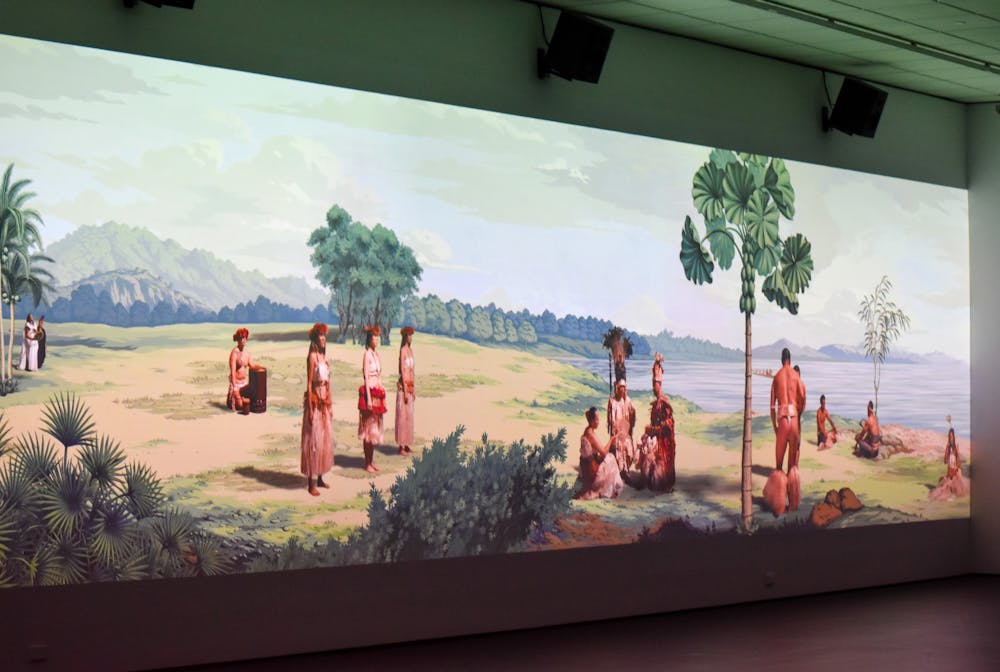Three Polynesian women donning grass skirts and wearing flowers on their heads dance gracefully on a lush green field. An 18th-century European man in full military garb works on a desk by the waterfront. A mother crouches in the grass and comforts her young son, rocking him back and forth.
Created by multi-disciplinary artist Lisa Reihana, the 64-minute multimedia immersive art installation “in Pursuit of Venus [infected]” projects scenes of 18th-century European exploration and colonization in the Pacific on a 70-foot wall in the David Winton Bell Gallery in List Art Center. The installation made its East Coast debut Feb. 21 and will remain at the gallery until May 29. A public reception and celebration for Reihana will be held at the gallery April 29 at 6 p.m.
Images of Indigenous and European individuals scroll through the projection in an “imagined Tahitian landscape,” said Kate Kraczon, director of exhibitions and chief curator at the Brown Arts Institute and the David Winton Bell Gallery.
In the exhibit’s program, Reihana wrote that she seeks to “challenge the stereotypes that developed in those times and since” of the Pacific. Through the installation, “the gaze of imperialism is turned back on itself with a speculative twist that disrupts notions of beauty, authenticity and history and uncovers myth-making,” she added.
The limited representation of Indigenous peoples in Joseph Dufour et Cie’s 19th-century wallpaper “Les Sauvages de la Mer Pacifique” — French for “The Native Peoples of the Pacific Ocean” — led Reihana to create “in Pursuit of Venus [infected]” with a goal to “reimagine what could have actually happened while knowing that authenticity is never possible,” Kraczon said.
As an artist of Māori descent, Reihana was not satisfied with the original wallpaper’s representation of 24 groups of Māori, Pacific and First Nations peoples, most of whom were depicted in Greco-Roman clothing and with Europeanized features, she wrote in the program. When she was commissioned to create such a large piece, Reihanna chose to center an image from the background of the wallpaper — the death of Captain James Cook — and more aptly portrayed the diversity of Indigenous communities.
“The fact that there’s always something going on in my periphery and I can’t keep track of everything at once definitely corresponds to how the cycles really did play out in history,” said Anthony Bishop-Gylys ’24, who attended the installation. “You can’t point to any one of them, but it’s multiple different things happening together.”
“in Pursuit of Venus [infected]” has a beginning, middle and end but runs on a loop of 32-minute cycles with no end credits. In the first cycle, Cook is depicted as a man. In the second, he is depicted as a woman. The piece included several other historical figures: Omai, a Raiatean man who traveled to Europe and accompanied Cook on his third voyage; Tupaia, a Raiatean priest, navigator and translator; and Joseph Banks, an English botanist.
“Reihana has transformed these utopian depictions of Captain James Cook’s voyages into surreal vignettes of curiosity, caution, desire and predation,” Kraczon wrote in an introductory pamphlet to the piece.
The exhibition displays a hand-painted seaside background superimposed with images of dozens of actors and performers filmed on a green screen. The piece uses five different projectors and images overlapped and synched onto the projection.
“Not only do you have five channels of video, you have multiple soundscapes that scroll alongside each vignette,” Kraczon explained. Viewers can hear distinct Pacific languages being spoken, the sounds of waves and animals native to Pacific regions, Hawaiian pahu drums and even Bach’s “The Art of the Fugue” during the projection.
After overlapping the video of the performers onto the hand-painted background, Reihana ensured that every individual had a shadow.
“It’s so impressive,” said Brianna Bridges ’24, who has been working three-hour shifts at the front desk of the Bell since the fall. “I (still) find myself seeing new things that I’ve never seen before.”





